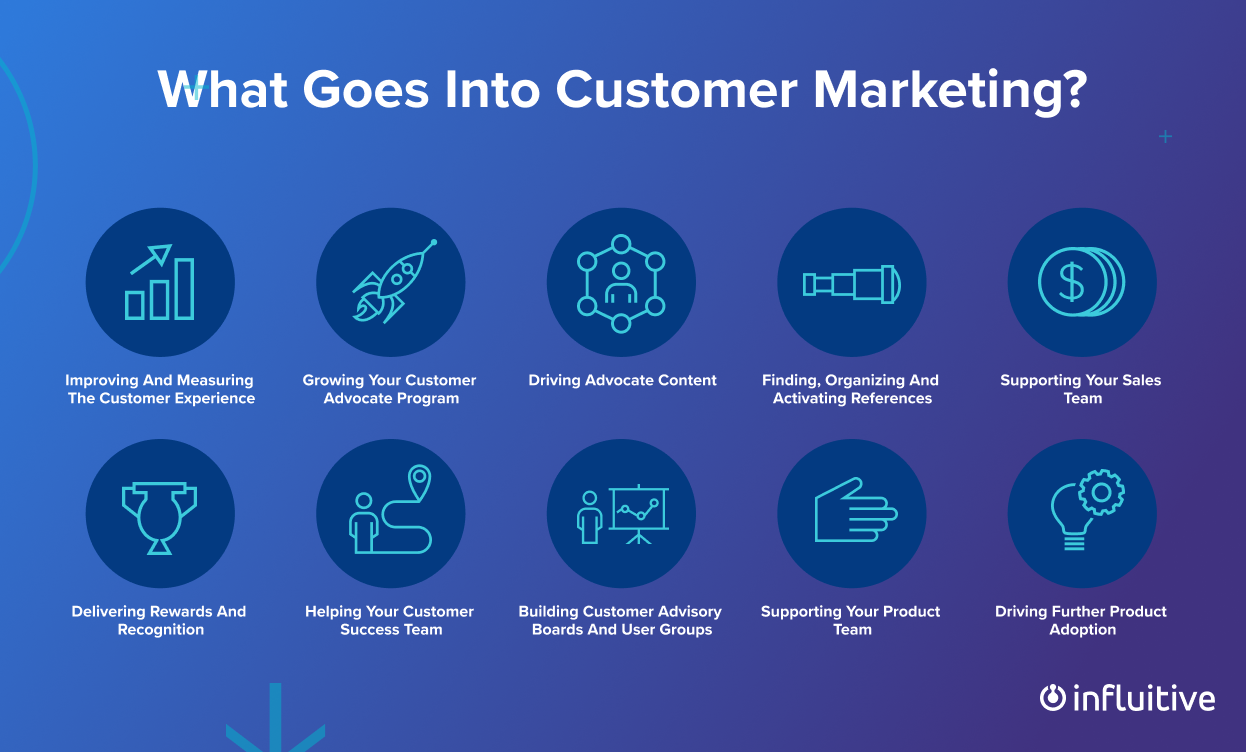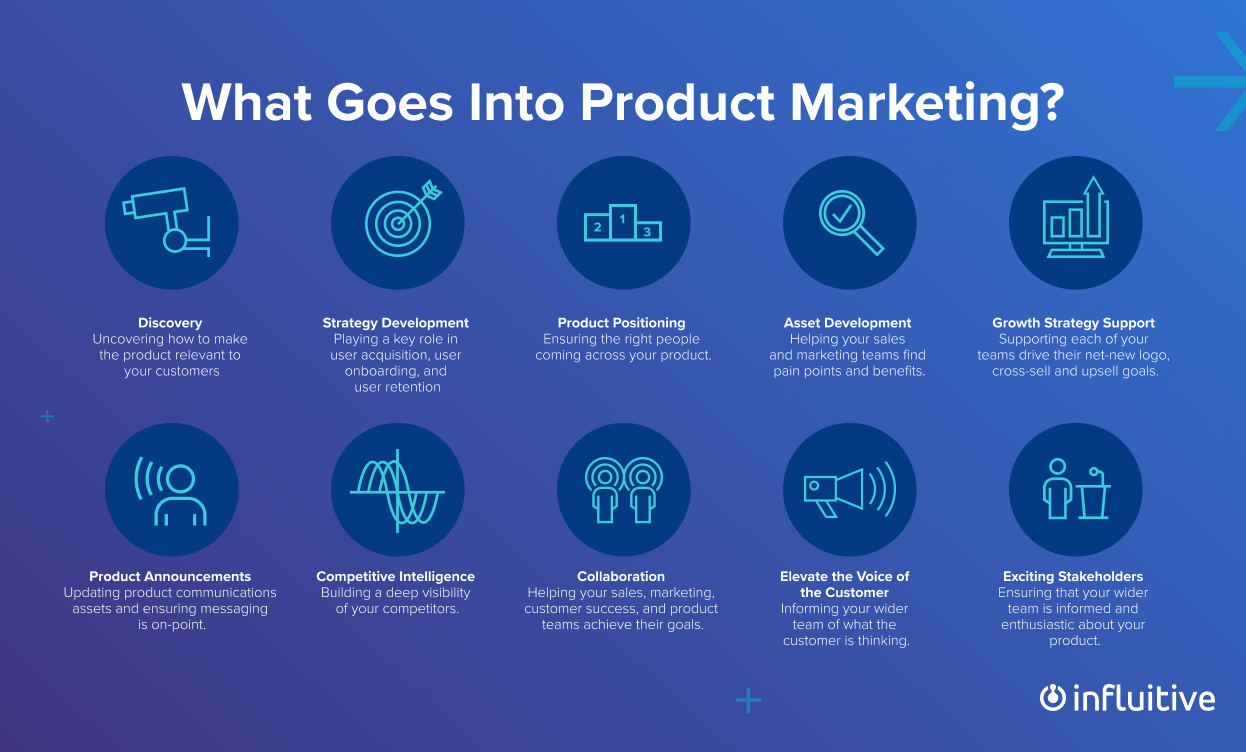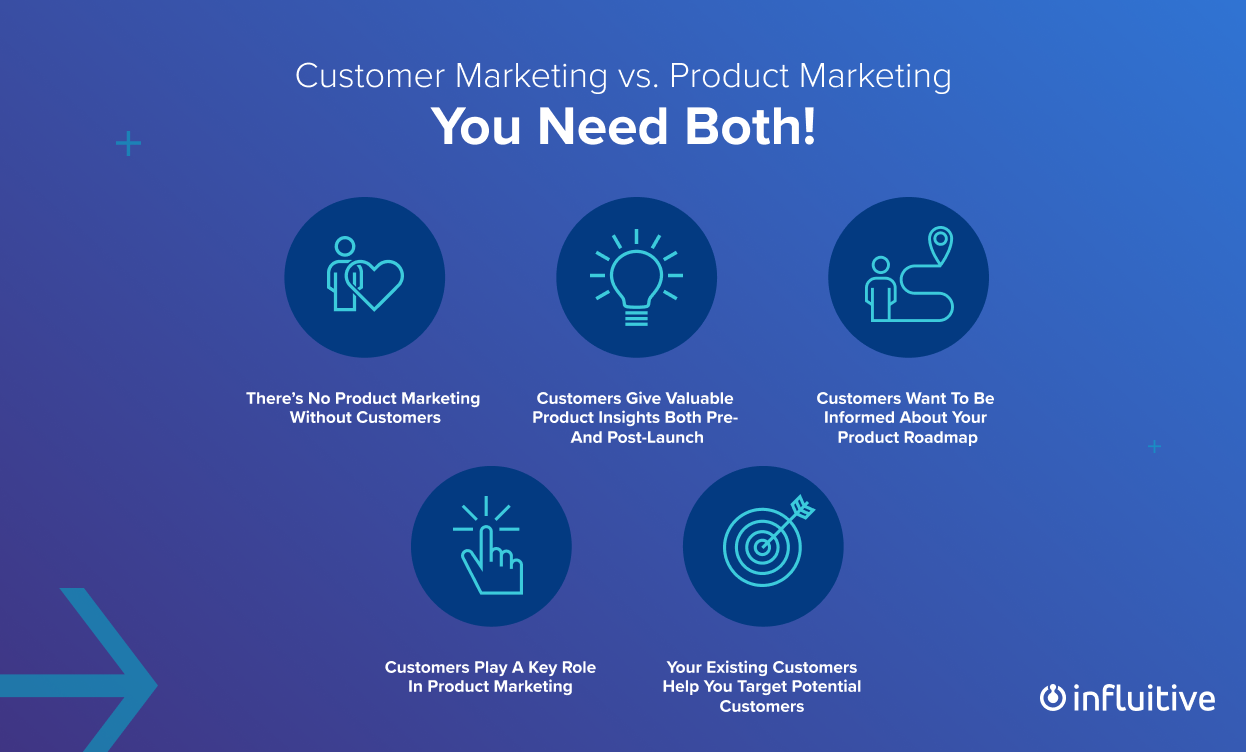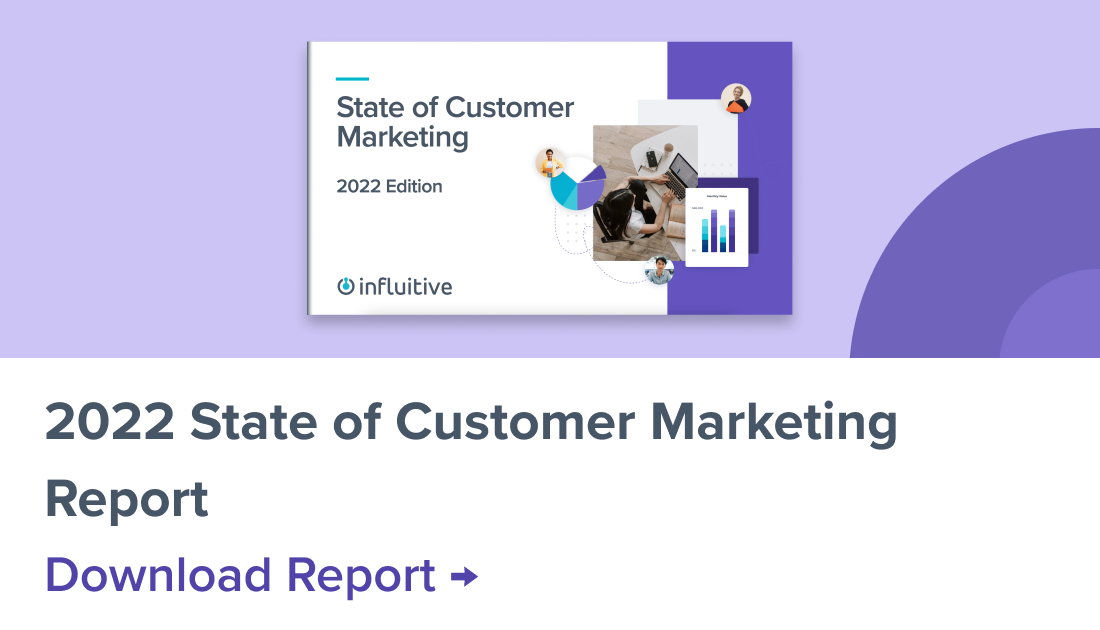Customer Marketing and Product Marketing are natural collaborators; you need both to be strong.
Product marketing focuses on bringing products to market and driving continuous success post-launch. Strong product marketers champion the voice of the customer, enable sales and marketing teams with potent assets, craft messaging, and drive adoption.
Customer marketing engages your existing customers. Customer marketers work to ensure your product’s users succeed, grow as individuals, and have a voice in your company. They build a journey that nurtures your customers into becoming brand advocates.
Customer marketing and product marketing reinforce each other. They power a growth engine that attracts new customers and keeps them engaged. In turn, their mutual focus on customers helps them champion the things customers want and need to be successful. These inputs inform company strategy, the product roadmap, and the tactics used to engage with customers.
In this guide, we’ll show you how to join your customer marketing and product marketing programs together for maximum impact on growth and profitability.
Customer Marketing vs. Product Marketing: Understanding Both
Before we get to how customer marketing and product marketing complement each other, we need to break down the work of each function.
What is Customer Marketing?

Customer marketing is about engaging customers at different points in the customer journey to help them onboard, adopt products/services, and succeed in their goals. It prioritizes building strong relationships with customers, discovering and nurturing customer advocates, and building customer communities.
Customer marketing creates vocal superfans of your brand, who write persuasive reviews and social proof, act as credible references, provide timely referrals, and much more!
What Does a Customer Marketing Strategy Look Like?
At a high-level, customer marketing strategies are built on the following goals:
Improve and Measure the Customer Experience
By focusing on the customer experience, customer marketers can find opportunities to surprise and delight customers. By delivering good service and providing tangible value, you build stronger relationships with your customers that go beyond typical professional connections.
Grow Your Customer Advocate Program
You want your customers to speak for your brand. At one level, customer marketers work to nurture your best customers into advocates. But at a deeper level, they work to ensure that customers can succeed both personally and professionally, which creates advocates.
Drive Advocate Content
Audiences want authentic stories because they are more trustworthy. Customer marketers mobilize your best customers to provide powerful social proof, like testimonials and reviews ensuring marketing and sales don’t show up empty-handed.
Find, Organize, and Activate References
No seller is properly equipped unless they have a deep bench of referenceable customers. Your customer marketing team takes the lead in building that roster. They handle the work of recruiting them, building relationships, managing legal/compliance issues, and more.
Support Your Sales Team
Customer marketers create a growth engine by creating campaigns that drive up-sell and cross-sell opportunities from your existing customers. They also play a crucial role in driving net-new acquisition by mobilizing customer advocacy, referrals, and references.

Deliver Rewards and Recognition
Your customer marketing team makes sure customers feel appreciated and valued. This is not just sending gift cards but instead delivering personalized and thoughtful experiences to your best customers.
Help Your Customer Success Team
Your customer marketing team helps to scale customer success efforts, reducing churn and increasing cross-sell and upsell opportunities. They engage your customers across their journey and, in turn, work to ensure they feel satisfied, engaged, and happy working with your brand.
Build Customer Advisory Boards and User Groups
Customer marketers organize customer advisory boards (CAB) and user groups (UG) as both facilitators and drivers. They identify the right customers to join these groups and empower customers to share honest feedback and help each other grow.
Support Your Product Team
By building strong, trusting relationships customer marketing teams often receive raw and unfiltered feedback. By sharing this feedback, your product team can tackle areas of real customer frustration, removing product friction and driving continuous innovation.
Drive Further Product Adoption
Finally, your customer marketing team helps with training/onboarding and equipping customers to adopt and succeed with your product. They help create content and experiences that drive product adoption and maintain it through the customer lifecycle.
What is Product Marketing?

Product marketing is responsible for understanding and successfully communicating the distinct value of products and services. It involves crafting the product’s value proposition, identifying target users, ensuring you have collateral or assets for launch, and informing customers.
In summary, you want to get your product in front of the right target customers/audience.
In fact, like customer marketers, product marketers must become customer experts to understand user needs and interests. Product marketers utilize their deep knowledge of the user to build scalable and personalized experiences that drive satisfaction, growth, and profit. Great product marketers champion the voice of their users and proactively work to celebrate and elevate diverse customer perspectives.
What Does a Product Marketing Strategy Look Like?
At a high-level, product marketing strategies focus on building processes that:
- Drive sales to acquire new customers
- Generate cross-sell and/or upsell opportunities with existing customers
- Support customer onboarding and product adoption efforts
- Elevate customer insights and pain points to leadership, marketing, and product teams
- Support customer renewal efforts
Here are a few of the key things that go into an effective product marketing strategy:
Discovery
Product marketers seek to understand markets, competitors, buyers, users, and the processes and systems that surround them. By combining market research, win/loss analysis, competitive intelligence, and feedback and surveying techniques, they develop deep knowledge that informs their strategic approach.
Strategy Development
Product marketing is tasked with finding the actionable insights that propel growth. These insights inform the go-to-market strategy for your products and services. They also play a key role in segmentation, user acquisition, user onboarding, and user retention.
Product Positioning
Product marketing positions your products and services to ensure that when the right people are investigating your product, they understand its unique value proposition. This includes creating detailed buyer personas and messaging.
Asset Development
Your sales and marketing teams need the right assets in order to move the needle and perform. Product marketers play a key role in creating those assets. Their deep understanding of personas and the value your business provides allows them to craft persuasive assets for any situation.
Uncovering Growth Opportunities
Each of your key teams (i.e., sales, marketing, customer success, product, etc) have to drive growth. The product marketing team supports each of these teams by identifying opportunities, creating growth strategies, and enabling teams to execute on those strategies.
Product Announcements
Product marketers are responsible for creating product announcements, both for new products and updates to existing products. They must effectively communicate the value of these new features and make it easy for consumers to try, buy, and adopt.
Elevate the Voice of the Customer
Product marketers continuously keep key teams informed on what customers are thinking and elevate the voice of the customer. This helps boost satisfaction rates, supports your retention, cross-sell and up-sell efforts, and, overall, makes your company more customer-centric.
Build Enthusiasm and Educate Stakeholders
Finally, your product marketers work to keep the team informed and aligned on the right way to talk about and sell your products. They ensure the right insights are provided to the right stakeholders at the right time.
Customer Marketing vs. Product Marketing: Why You Need Both

1. There’s No Product Marketing Without Customers
Product marketing works best when customer feedback is heard early and often. In this sense, customer marketing can play a big role in exposing product marketers to customers. Customer marketing can also encourage customers to engage more with the product marketing team via engagement, rewards, etc.
2. Customers Give Valuable Product Insights Both Pre- and Post-Launch
Customers always have valuable insights about your products and how you position them. Both product and customer marketers actively work to uncover these insights.
Product marketers, need to understand the pain points of using a product. Customers might have problems understanding the benefit of a feature, or how to use it properly. This information allows product marketers to raise concerns with the product team and create assets to help customers.
Customer marketing wants to hone in on the features customers love. They want the customer to start advocating for your brand. Product marketers need to know those strong points, as it helps with competitive intelligence, messaging, and positioning.
3. Customers Want to be Informed About Your Product Roadmap
There’s not a single customer on earth who’s not interested in the product roadmap. This is a key piece that product marketing and product management teams handle. However, customer marketing can play a role in helping product marketing find out what specific things customers want to know or are interested in.
4. Customer Communities Play a Key Role in Product Marketing
Customer communities are one of the most important marketing channels of this century. They may live on LinkedIn, Slack, or a dedicated community platform. But in every case, they’re full – and we repeat, FULL – of valuable insights. This includes product ideas, points of confusion or friction, and more. They’re also great places to teach customers about a product and to drive adoption.
5. Your Existing Customers Help You Target Potential Customers
If you are obsessed with the people who are using your product, you will form a clear vision of your ideal customer.
You can use this information in marketing to drive content creation and target your campaigns. In the product team, you can build the right personas. With the sales team, you tailor your pitches at a more precise level. In the customer success team, you can better align your support to the goals of the customers. And in the services team, you could develop better and more effective implementation, strategy, and design.
Invest in Your Customer Marketing and Product Marketing
There’s a common theme underpinning our discussion. It’s about becoming customer-obsessed.
Together, customer marketing and product marketing play key roles in putting customers at the center of your company. This shift unlocks new growth potential for your company across both your existing customers and net-new logos. It also helps recession-proof your marketing efforts and set it up for success in a bull-market.
Alex Ruddock runs Product Marketing at Influitive. With a background in computer science and neuroscience, he has a love for data, systems, and psychology. He loves working together with customers to push the Influitive platform and the market forward.
Learn More About Customer Marketing and Advocacy:
- What is Customer Advocacy?
- Customer Marketing Ideas You Need to See
- Customer Marketing Examples to Try Today











































